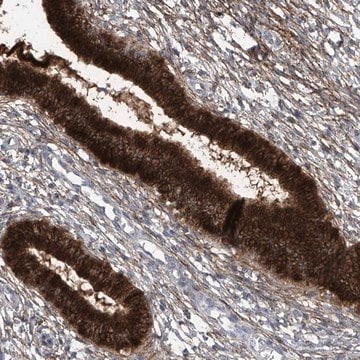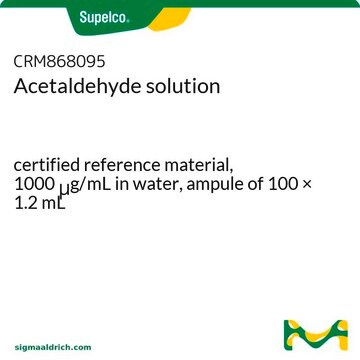Wichtige Dokumente
868095
Acetaldehyd -Lösung
1000 μg/mL in H2O, analytical standard
About This Item
Empfohlene Produkte
Qualität
analytical standard
Analysenzertifikat (CofA)
certificate of analysis is enclosed in each package.
Verpackung
ampule of 100 × 1.2 mL
Konzentration
1000 μg/mL in H2O
Methode(n)
HPLC: suitable
gas chromatography (GC): suitable
Dichte
0.868 g/mL at 20 °C
Format
single component solution
Lagertemp.
2-8°C
SMILES String
[H]C(C)=O
InChI
1S/C2H4O/c1-2-3/h2H,1H3
InChIKey
IKHGUXGNUITLKF-UHFFFAOYSA-N
Suchen Sie nach ähnlichen Produkten? Aufrufen Leitfaden zum Produktvergleich
Anwendung
Sonstige Hinweise
Ersetzt durch
Signalwort
Danger
H-Sätze
Gefahreneinstufungen
Carc. 1B
Lagerklassenschlüssel
6.1D - Non-combustible acute toxic Cat.3 / toxic hazardous materials or hazardous materials causing chronic effects
WGK
WGK 3
Flammpunkt (°F)
Not applicable
Flammpunkt (°C)
Not applicable
Persönliche Schutzausrüstung
Eyeshields, Gloves
Zulassungslistungen
Zulassungslistungen werden hauptsächlich für chemische Produkte erstellt. Für nicht-chemische Produkte können hier nur begrenzte Angaben gemacht werden. Kein Eintrag bedeutet, dass keine der Komponenten gelistet ist. Es liegt in der Verantwortung des Benutzers, die sichere und legale Verwendung des Produkts zu gewährleisten.
EU REACH Annex XVII (Restriction List)
Hier finden Sie alle aktuellen Versionen:
Besitzen Sie dieses Produkt bereits?
In der Dokumentenbibliothek finden Sie die Dokumentation zu den Produkten, die Sie kürzlich erworben haben.
Kunden haben sich ebenfalls angesehen
Unser Team von Wissenschaftlern verfügt über Erfahrung in allen Forschungsbereichen einschließlich Life Science, Materialwissenschaften, chemischer Synthese, Chromatographie, Analytik und vielen mehr..
Setzen Sie sich mit dem technischen Dienst in Verbindung.










